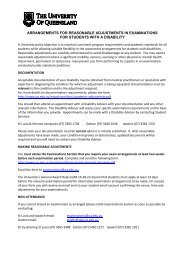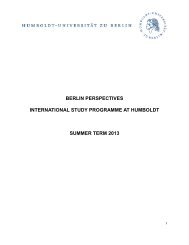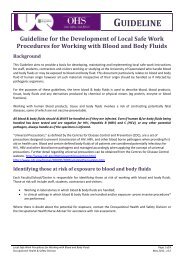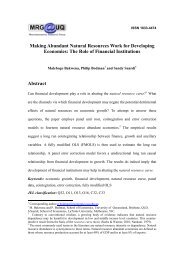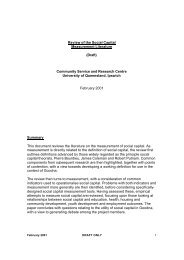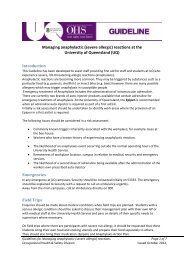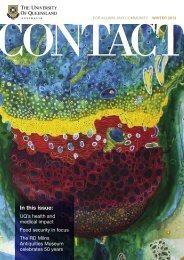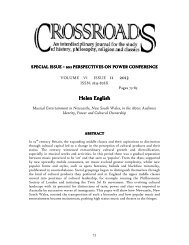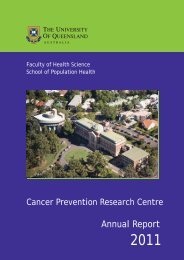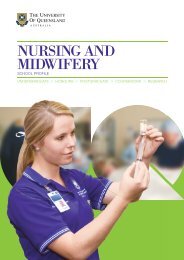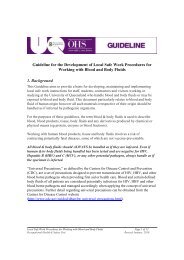Mechanical disruption of seagrass in the digestive tract of the dugong
Mechanical disruption of seagrass in the digestive tract of the dugong
Mechanical disruption of seagrass in the digestive tract of the dugong
You also want an ePaper? Increase the reach of your titles
YUMPU automatically turns print PDFs into web optimized ePapers that Google loves.
<strong>Mechanical</strong> <strong>disruption</strong> <strong>of</strong> <strong>seagrass</strong> by <strong>the</strong> <strong>dugong</strong><br />
J. M. Lanyon and G. D. Sanson<br />
This paper <strong>in</strong>vestigates <strong>the</strong> degree <strong>of</strong> breakdown <strong>of</strong><br />
<strong>seagrass</strong> digesta along <strong>the</strong> gut <strong>of</strong> <strong>dugong</strong>s and relates this to<br />
<strong>the</strong> functional surface area <strong>of</strong> <strong>the</strong> mouthparts and nature <strong>of</strong><br />
<strong>the</strong> diet. We exam<strong>in</strong>e how <strong>dugong</strong>s cope with a fibrous plant<br />
diet <strong>in</strong> <strong>the</strong> absence <strong>of</strong> an effective hard dentition.<br />
Methods<br />
Digesta analysis<br />
Digesta samples were obta<strong>in</strong>ed from 41 <strong>dugong</strong>s. These<br />
samples <strong>in</strong>cluded stomach samples <strong>in</strong> 10% neutral buffered<br />
formal<strong>in</strong> from 29 <strong>dugong</strong>s that had accidentally drowned <strong>in</strong><br />
set nets <strong>in</strong> north Queensland, and now form part <strong>of</strong> <strong>the</strong><br />
Museum <strong>of</strong> Tropical Queensland specimen collection. Skull<br />
and mouthparts measurements were possible for 28 specimens.<br />
Faecal samples were available from two captive and<br />
five wild animals.<br />
In addition, five fresh whole <strong>digestive</strong> <strong>tract</strong>s (four adults<br />
and one calf) were obta<strong>in</strong>ed from <strong>dugong</strong>s that had been<br />
accidentally drowned or hunted <strong>in</strong> nor<strong>the</strong>rn Australia dur<strong>in</strong>g<br />
<strong>the</strong> course <strong>of</strong> this study. These <strong>tract</strong>s were frozen soon<br />
after collection. Digesta samples (up to 250 g) were obta<strong>in</strong>ed<br />
from five regions along each complete adult <strong>digestive</strong> <strong>tract</strong><br />
when available: (1) <strong>the</strong> anterior region <strong>of</strong> <strong>the</strong> stomach,<br />
(2) <strong>the</strong> anterior small <strong>in</strong>test<strong>in</strong>e (duodenum), (3) <strong>the</strong> posterior<br />
small <strong>in</strong>test<strong>in</strong>e, (4) <strong>the</strong> caecum and (5) <strong>the</strong> posterior colon<br />
(=faeces). In <strong>the</strong> calf, digesta samples were available from<br />
<strong>the</strong> stomach and colon only. Ex<strong>tract</strong>ed gut contents were<br />
fixed <strong>in</strong> 10% neutral buffered formal<strong>in</strong>.<br />
Dietary composition<br />
The dietary composition <strong>of</strong> each digesta sample was determ<strong>in</strong>ed<br />
to genus us<strong>in</strong>g a micro-stereological technique<br />
(Channells & Morrissey, 1981; Lanyon, 1986). In most<br />
cases, digesta could only be identified from leaf material <strong>of</strong><br />
<strong>the</strong> largest particle size classes (41.6 mm) so that <strong>the</strong> bulk <strong>of</strong><br />
each stomach sample could not be identified. Apparent<br />
dietary composition was expressed <strong>in</strong> terms <strong>of</strong> percentage<br />
volume <strong>of</strong> each identifiable genus <strong>of</strong> <strong>seagrass</strong> present.<br />
Particle size distribution<br />
Digesta samples were wet sieved <strong>in</strong>to eight particle size<br />
classes us<strong>in</strong>g Endecott sieves with mesh sizes <strong>of</strong> 4 mm,<br />
1.6 mm, 1 mm, 500 mm, 250 mm, 125 mm and 75 mm. To<br />
alleviate <strong>the</strong> problem <strong>of</strong> particles be<strong>in</strong>g deformed and forced<br />
through <strong>the</strong> sieve, water pressure was m<strong>in</strong>imized. Particles<br />
were separated on <strong>the</strong> basis <strong>of</strong> maximum dimension. The<br />
particulate content <strong>of</strong> each sieve was oven dried at 55 1C<br />
overnight to constant weight. Particulate matter from <strong>the</strong><br />
wash<strong>in</strong>gs <strong>of</strong> <strong>the</strong> f<strong>in</strong>est sieve was collected through centrifug<strong>in</strong>g<br />
and filter<strong>in</strong>g. It was considered that <strong>the</strong> amount <strong>of</strong><br />
matter filtered through paper with pore size 6 mm was<br />
negligible because <strong>the</strong> filtrate was clear. All particles from<br />
<strong>the</strong> largest sieve size, that is 44 mm, had maximum dimensions<br />
<strong>of</strong> o8 mm.<br />
Mouthparts<br />
The results <strong>of</strong> <strong>the</strong> <strong>in</strong>vestigation <strong>in</strong>to <strong>the</strong> morphology and<br />
functional occlusion <strong>of</strong> <strong>the</strong> dentition <strong>of</strong> a total <strong>of</strong> 57 <strong>dugong</strong><br />
specimens have been presented elsewhere (Lanyon & Sanson,<br />
2006). Crown surface areas <strong>of</strong> cheek teeth from <strong>the</strong>se<br />
dead stranded <strong>dugong</strong>s from tropical north Queensland<br />
were measured. For 29 <strong>of</strong> <strong>the</strong>se specimens, digesta contents<br />
were also available (see above). The surface area <strong>of</strong> each<br />
erupted cheek tooth was digitized <strong>in</strong> planar view from<br />
trac<strong>in</strong>gs made us<strong>in</strong>g a Nikon V12 pr<strong>of</strong>ile projector at 5<br />
magnification under reflected light. These measurements<br />
were considered representative because <strong>dugong</strong> teeth wear<br />
relatively flat with age. Occlusal or functional surface area<br />
was estimated by sub<strong>tract</strong><strong>in</strong>g non-functional tooth areas<br />
[i.e. those coated with calculus, partially erupted or nonocclud<strong>in</strong>g<br />
teeth (Sanson, 1980)], from <strong>the</strong> total tooth surface<br />
area (Lanyon & Sanson, 2006).<br />
For each <strong>of</strong> 57 specimens, <strong>the</strong> surface area <strong>of</strong> <strong>the</strong> lower<br />
horny pad was measured through approximation to <strong>the</strong><br />
surface area <strong>of</strong> <strong>the</strong> underly<strong>in</strong>g bony attachment area on <strong>the</strong><br />
symphysial part <strong>of</strong> <strong>the</strong> mandible (Lanyon & Sanson, 2006).<br />
The anterior edge <strong>of</strong> <strong>the</strong> horny pad was def<strong>in</strong>ed as runn<strong>in</strong>g<br />
along <strong>the</strong> edge <strong>of</strong> <strong>the</strong> most anterior <strong>in</strong>cisor socket, and <strong>the</strong><br />
posterior edge along <strong>the</strong> dorsal marg<strong>in</strong> <strong>of</strong> <strong>the</strong> deflected<br />
portion <strong>of</strong> <strong>the</strong> dentary, that is <strong>the</strong> posterior end <strong>of</strong> <strong>the</strong> lower<br />
<strong>in</strong>cisor socket row (Fig. 1). The surface area <strong>of</strong> each traced<br />
lower pad was measured digitally on an image analyser.<br />
Because <strong>the</strong> upper and lower pads work <strong>in</strong> opposition, <strong>the</strong><br />
lower pad was considered to be representative <strong>of</strong> <strong>the</strong> functional<br />
pad area. The surface area <strong>of</strong> mouthparts (dentition<br />
and horny pads) was expressed <strong>in</strong> terms <strong>of</strong> age across<br />
specimens from a wide age range (o1 to 46 years; animals<br />
<strong>of</strong> age o1 year were given an age <strong>of</strong> 0.5 years) for which<br />
<strong>in</strong>tact skulls were available. The age <strong>of</strong> each <strong>dugong</strong> specimen<br />
had previously been estimated by count<strong>in</strong>g <strong>the</strong> dent<strong>in</strong>al<br />
growth layer groups <strong>in</strong> <strong>the</strong> erupted and non-erupted tusks<br />
(Marsh, 1980).<br />
In vitro breakdown <strong>of</strong> <strong>seagrass</strong><br />
Leaf samples <strong>of</strong> five <strong>seagrass</strong>es that form part <strong>of</strong> <strong>the</strong><br />
<strong>dugong</strong>’s diet [Halophila ovalis, Halodule (narrow-leaf<br />
morph), Halodule un<strong>in</strong>ervis (broad-leaf morph), Cymodocea<br />
serrulata and Zostera capricorni] and three common Australian<br />
terrestrial pasture grasses [Triticum aestivum<br />
(19-day-old wheat), Koeleria setacea and Erharta erecta]<br />
were subjected to <strong>in</strong> vitro mechanical damage to compare<br />
<strong>the</strong>ir susceptibility to fracture. Similar-sized samples <strong>of</strong> each<br />
<strong>of</strong> <strong>the</strong> fresh grasses were placed <strong>in</strong> 40 mL <strong>of</strong> 0.1 M phosphate<br />
buffer (pH 6.8) with<strong>in</strong> <strong>in</strong>dividual lubricated, th<strong>in</strong>-walled,<br />
dot-ribbed, supersensitive latex balloons. Each sample was<br />
subjected to 60 m<strong>in</strong> <strong>of</strong> gr<strong>in</strong>d<strong>in</strong>g under constant pressure <strong>in</strong> a<br />
peristaltic pump fitted with metal rollers. Resultant plant<br />
breakdown was assessed visually and qualitatively. Fur<strong>the</strong>r,<br />
278<br />
Journal <strong>of</strong> Zoology 270 (2006) 277–289 c 2006 The Authors. Journal compilation c 2006 The Zoological Society <strong>of</strong> London




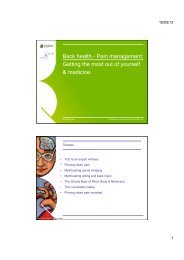
![Recycling [ PDF, 62KB ] - University of Queensland](https://img.yumpu.com/51805185/1/184x260/recycling-pdf-62kb-university-of-queensland.jpg?quality=85)
